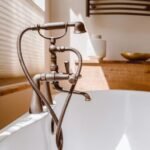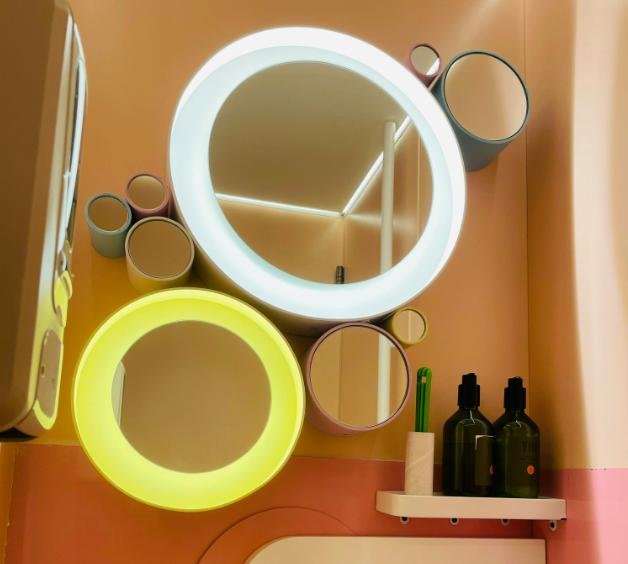Introduction to Bathtub Faucet Issues
Bathtub faucets are essential fixtures in any home, providing the necessary water supply for bathing and relaxation. However, like many plumbing components, they can encounter various issues that affect their performance. Among the most common problems faced by homeowners is the slow-running bathtub faucet, which can significantly impact daily routines. Understanding the root causes of this issue is crucial to maintaining a functional plumbing system and ensuring an enjoyable bathing experience.
A slow water flow from a bathtub faucet can stem from multiple sources, including mineral deposits, clogged aerators, or worn-out washers. Hard water can leave behind minerals that accumulate within the faucet and pipes, leading to a constricted flow rate. Regularly inspecting the faucet and cleaning any aerators can mitigate these issues and promote optimal water delivery. Moreover, over time, components such as washers and O-rings may degrade, causing leaks or reduced water pressure. Being aware of these potential problems can help homeowners identify when to seek repairs or replacements.
Beyond the immediate inconvenience of a slow-running faucet, such issues can have broader implications. For instance, if a faucet operates inefficiently, it could result in increased water bills or extended wait times for hot water to reach the tub. Furthermore, persistent problems with faucet performance might indicate underlying plumbing concerns that require attention. Hence, recognizing early signs of faucet trouble and understanding their implications can ultimately assist homeowners in preserving their plumbing systems while ensuring efficient water use.
Common Causes of Slow Water Flow
A slow-running bathtub faucet can be frustrating, and understanding the common causes of this issue is essential for finding effective solutions. One of the primary reasons for reduced water flow is mineral build-up. Over time, minerals such as calcium and magnesium can accumulate in the faucet aerator or within the plumbing itself, leading to restricted water passage. Regular maintenance to clean these fixtures can help prevent this issue.
Another significant cause of slow water flow relates to water pressure issues. If the overall water pressure in the home is low, it can affect all fixtures, including the bathtub faucet. Low water pressure can arise from various sources, including leaks in the plumbing system, issues with the municipal water supply, or a malfunctioning pressure reducing valve. Testing the water pressure can help identify whether this is the underlying issue. If it is determined to be a water pressure problem, steps can be taken to address it directly, such as repairing leaks or adjusting the pressure-reducing valve.
Moreover, valve problems can also contribute to slow water flow. The bathtub faucet typically includes a valve that controls the flow of water. If this valve is partially closed or malfunctioning, it can lead to a significant decrease in water flow. Attempting to adjust the valve may improve water delivery, but in some cases, replacing the faulty valve might be necessary to restore proper function.
These common causes—mineral build-up, water pressure issues, and valve problems—often underpin the frustrating experience of a slow-running bathtub faucet. By identifying one or more of these issues, homeowners can take appropriate action to enhance water flow and enjoy a more comfortable bathing experience.
Checking Water Pressure
Checking the water pressure in your home is a crucial step in diagnosing issues with a slow-running bathtub faucet. Low water pressure can significantly contribute to a reduced flow rate, impacting your overall bathing experience. To determine if your water pressure is within the recommended range, you will need a simple tool known as a pressure gauge. These can be easily obtained from hardware stores or online retailers.
To properly measure your water pressure, first, locate an outdoor spigot or a faucet that is easily accessible. The pressure gauge is designed to fit onto the threaded outlet of the faucet. Begin by ensuring that the faucet is fully opened. Attach the pressure gauge and turn on the water supply. The gauge will provide a reading in pounds per square inch (PSI). Ideally, the water pressure in most homes should range between 40 and 60 PSI. If your reading falls significantly below this range, it indicates low water pressure, which can be a primary cause behind the slow flow from your bathtub faucet.
If you find that your water pressure is low, there are several methods to troubleshoot the issue. First, ensure that the main shut-off valve is fully opened; if it is partially closed, it may restrict water flow. Additionally, check for any obstructions or mineral buildup in the faucet aerator or installed pressure regulators. Over time, these components can accumulate debris, further hindering water flow. In some cases, low water pressure could stem from issues within your municipal water supply, which might require inquiry from your water provider.
By regularly checking your water pressure, you can identify potential problems early, thereby ensuring that your bathtub faucet and other plumbing fixtures are functioning effectively.
The Role of Mineral Deposits
One of the primary reasons for a slow-running bathtub faucet is the accumulation of mineral deposits, particularly calcium and lime. These deposits often originate from hard water, which contains a high concentration of minerals. Over time, through continuous exposure to such water, these minerals can build up within the faucet aerators and the plumbing pipes themselves. The slow accumulation leads to reduced water flow, causing frustration for users who expect a steady stream from their faucets.
Mineral deposits can specifically affect the faucet aerator, which is designed to regulate the water flow and mix air with water to produce a steady and splash-free stream. When calcium and lime accumulate within the aerator, the opening becomes restricted, severely impacting the flow rate of water. This issue can often be overlooked, as users might attribute the slow flow to general wear and tear or plumbing issues, rather than considering the impact of mineral build-up.
To combat this problem, it is advisable to regularly remove and clean the faucet aerator. A simple solution involves soaking the aerator in a vinegar solution, which helps dissolve the mineral deposits. After soaking for several hours, brushing the aerator with a soft-bristled toothbrush can further aid in removing stubborn deposits. For more extensive cases, where mineral build-up occurs deeper within the plumbing, a professional cleaning service might be required to restore the faucet’s normal function.
Incorporating a water softener system in the home can also mitigate the effects of hard water, reducing the frequency of mineral deposit accumulation. By addressing mineral deposits promptly, homeowners can ensure their bathtub faucets maintain optimal performance, enhancing both usability and satisfaction.
Faucet Aerator Cleaning and Maintenance
A bathtub faucet aerator is a small device that mixes air with water, resulting in a more efficient flow and reduced water usage. Over time, mineral deposits and debris can accumulate, leading to decreased water flow and a sluggish faucet. Regular cleaning of the faucet aerator is crucial to ensure that it operates effectively and to avoid the inconvenience of low water pressure. Below are the steps to properly clean or replace a faucet aerator.
To begin, turn off the water supply to the bathtub faucet. This will prevent any unexpected water flow while you are working on the aerator. Next, use a pair of pliers or a wrench to gently remove the aerator from the end of the faucet. Be sure to wrap a cloth around the aerator to protect its finish from scratches during the removal process. Once removed, examine the aerator for any visible buildup or debris.
If the aerator appears dirty, soak it in a solution of equal parts vinegar and water for about 30 minutes. This solution will help dissolve mineral deposits and stubborn grime. After soaking, use an old toothbrush to scrub the aerator gently, ensuring that all parts are clean. Rinse thoroughly under running water to remove any residual vinegar or debris. Once clean, reattach the aerator to the faucet, ensuring it is secured correctly but not overtightened to avoid damage.
In instances where the aerator is heavily damaged or corroded, replacing it is the best option. Most home improvement stores carry a variety of aerators that can be easily installed. Regular maintenance, including checking and cleaning the aerator every few months, can help maintain optimal water flow, preventing any slow-running issues with the bathtub faucet. By understanding the importance of aerator care, homeowners can enjoy a consistent and efficient faucet performance.
Investigating Valve Issues
When dealing with a slow-running bathtub faucet, one of the primary culprits may be valve-related problems. Valves are critical components in plumbing systems, responsible for regulating the flow of water. There are several types of valves utilized in bathtub faucets, including compression valves, cartridge valves, ball valves, and disk valves. Each type functions differently, and understanding their mechanics can assist in diagnosing issues.
Compression valves are traditional and operate through the use of rubber washers that can wear out over time, leading to reduced water flow. Cartridge valves, which are more commonly found in modern faucets, contain a cartridge that controls the flow and temperature of water. If this cartridge becomes clogged or damaged, it can significantly hinder performance. Ball valves and disk valves represent other common types, each susceptible to unique issues such as mineral deposits or wear that can restrict flow.
Identifying faulty valves can often be a straightforward process. Signs of valve issues may include inconsistent water pressure, an inability to adjust temperature, or noticeable leaks around the faucet. When water does not flow freely, a thorough examination of the valve is warranted. This may involve disassembling the faucet and inspecting for visible damage or obstructions. Additionally, mineral buildup, particularly in hard water areas, can form deposits that restrict water flow through the valve. Regular maintenance and cleaning can mitigate these issues to some extent.
If after inspection a valve is determined to be faulty or ineffective, repairs or replacements may be necessary. Replacing a damaged valve can restore the proper functionality of a bathtub faucet, often resulting in improved water flow. In conclusion, actively investigating valve-related issues is essential for addressing slow water flow in bathtub faucets, ensuring both effective operation and longevity of the plumbing system.
Piping Problems and Solutions
When dealing with a slow-running bathtub faucet, one of the foremost areas to investigate is the piping system. The water flow may be impeded by various piping problems, and understanding these issues is essential for effective troubleshooting.
One common issue is pipe obstructions, which can occur due to the accumulation of mineral deposits, debris, or even small animals that have nested in the pipes. These blockages can significantly restrict water flow. To evaluate this potential problem, homeowners may consider conducting a visual inspection, using a plumbing snake, or employing a water camera. If a blockage is confirmed, clearing it might involve using a plumber’s snake or a high-pressure water jetting technique to restore proper flow.
Leaky pipes also contribute to reduced pressure at the bathtub faucet. When water escapes through leaks, it may result in decreased water availability at the tap, creating the illusion of a slow-running faucet. Identifying leaks can be done by checking for damp spots on walls or ceilings, or by monitoring water meter readings for unexplained increases. To address leaks, homeowners might need to replace affected sections of the piping or utilize pipe sealants, depending on the severity and location of the leak.
Corrosion is another critical factor that can affect the performance of bathtub faucets. Over time, pipes can corrode due to exposure to water and environmental elements, resulting in rust buildup that disrupts water flow. Recognizing the signs of corrosion, such as discolored water or flaking pipe surfaces, is vital. In such cases, it might be necessary to consult a professional plumber to assess the extent of the damage and suggest replacement or repairs to the corroded piping.
Addressing these piping problems effectively not only enhances the performance of a bathtub faucet but also extends the lifespan of the entire plumbing system.
When to Call a Professional
Determining when to call a professional for a slow-running bathtub faucet can be crucial for maintaining the efficiency and functionality of your plumbing system. While some minor issues can be handled through simple DIY methods, there are specific scenarios where seeking professional plumbing services becomes essential.
Firstly, if you have attempted basic troubleshooting – such as cleaning or replacing the faucet aerator and observing no improvement in water flow, it may indicate a deeper issue within the plumbing system. Often, low water pressure can result from problems such as mineral buildup in the pipes or an obstruction within the plumbing itself that requires specialized tools and expertise to resolve.
Another instance that signals the need for professional help is when you notice any unusual sounds or smells coming from the faucet or the surrounding plumbing. These could indicate issues such as leaks, air pockets, or contamination in the water supply. Ignoring these warning signs can lead to more severe plumbing problems, contributing to potential damage to your home and increased repair costs.
Additionally, if you are considering modifications to your existing plumbing system or installing a new faucet altogether, enlisting the skills of a licensed plumber is advisable. Their experience ensures that any work completed adheres to local codes and standards, ultimately leading to safe and efficient operation.
For more serious issues like a significant drop in water pressure throughout your home or visible leaks in your plumbing system, it is imperative to contract the services of a professional right away. Doing so can help identify and rectify the root cause of the slow-running bathtub faucet timely, preventing further complications down the line.
Preventative Measures for Future Issues
Maintaining a bathtub faucet in optimal condition is essential for ensuring consistent water flow and preventing slow-running issues. Homeowners can implement several preventative measures to minimize the likelihood of such problems arising in the future. Regular maintenance practices play a crucial role in maintaining the faucet’s performance and functionality.
One of the most effective strategies is to schedule routine inspections of the faucet and associated plumbing components. Homeowners should inspect for visible signs of wear, corrosion, or mineral buildup, which can impede water flow over time. A simple visual check can help identify early warning signs that, if left unaddressed, could lead to more significant plumbing issues.
To further enhance the function of a bathtub faucet, employing a water softening system can be beneficial in areas with hard water. Hard water is often rich in minerals such as calcium and magnesium, which can accumulate within the faucet and cause blockages. By softening the water supply, homeowners can significantly reduce mineral buildup, helping to maintain optimal flow rates.
Additionally, regularly cleaning the aerator screen or faucet head is recommended to ensure that any debris or sediment can be removed. Periodic disassembly and cleaning of the faucet components can help maintain efficient operation. It is advisable to use manufacturer-recommended tools and solutions to avoid damaging the faucet during cleaning.
Lastly, documenting and tracking maintenance activities can be a helpful practice, allowing homeowners to recognize patterns in performance and identify when professional assistance may be necessary. By adopting these proactive measures, homeowners can significantly reduce the chances of encountering slow bathtub faucet problems, ensuring a smooth and efficient operation for years to come.








